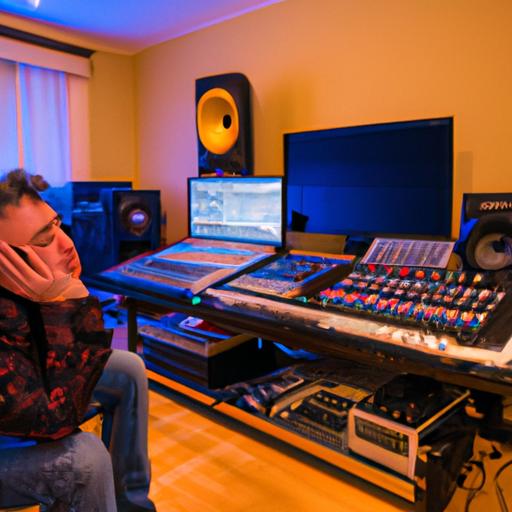What Is the Best Free Music Making Software?
Are you a budding musician or an aspiring music producer looking to create your own beats and melodies? If so, you’ve come to the right place. In today’s digital age, music making software has become an essential tool for artists of all levels. But with so many options available, how do you know which one is the best? In this article, I’ll guide you through the world of free music making software and help you find the perfect fit for your creative needs.
A. Importance of Music Making Software
Music making software, also known as digital audio workstations (DAWs), is a game-changer for musicians. It allows you to compose, record, edit, and mix your own music right from the comfort of your own home or studio. Gone are the days of needing expensive equipment and professional recording studios to create high-quality tracks. With the right software, you can unleash your creativity and bring your musical ideas to life.
B. Overview of Free Music Making Software Options
Now, you might be wondering, are there any free options available? Absolutely! In fact, there are several fantastic free music making software programs that offer a wide range of features and capabilities. These software options provide an excellent starting point for beginners or those on a tight budget. While they may not have all the bells and whistles of their paid counterparts, they can still deliver impressive results.
In the next section, we’ll delve deeper into the world of music making software and explore the benefits of opting for free options. So, get ready to embark on a musical journey and discover the best free music making software out there. Let’s dive in!
Understanding Music Making Software
Music making software, also known as digital audio workstations (DAWs), is a powerful tool that empowers musicians and producers to create, edit, and manipulate audio in a digital environment. Whether you’re a bedroom producer or a professional musician, understanding the fundamentals of music making software is crucial to harnessing its potential.
A. Definition and Purpose of Music Making Software
Music making software refers to a range of computer programs designed to facilitate music composition, recording, editing, and production. These software applications provide a virtual workspace where musicians can manipulate and arrange audio tracks, apply effects, mix multiple elements, and export their final compositions.
The purpose of music making software is to streamline the music production process, allowing artists to bring their creative ideas to fruition without the need for expensive hardware or recording studios. With a user-friendly interface and a vast array of tools and instruments at your disposal, music making software eliminates barriers and empowers artists to explore their creativity.
B. Key Features to Consider When Choosing Software
When selecting the right music making software for your needs, it’s essential to consider certain key features that can greatly enhance your music production experience. Here are a few features to keep in mind:
-
User Interface: Look for software with an intuitive and user-friendly interface. A well-designed interface can save you time and frustration, allowing you to focus on your creativity rather than getting lost in complex menus and controls.
-
Compatibility: Ensure that the software is compatible with your operating system. Whether you’re using Windows, macOS, or Linux, choose a software that seamlessly integrates with your setup.
-
Instruments and Plugins: Consider the variety and quality of virtual instruments and audio plugins included in the software. A rich library of instruments and effects can expand your sonic palette and add depth to your compositions.
-
Support and Community: Look for software that offers reliable technical support and has an active user community. Having access to tutorials, forums, and resources can greatly enhance your learning curve and help you overcome any obstacles along the way.
By understanding the core concepts and features of music making software, you’ll be better equipped to make an informed decision when choosing the right software for your musical journey. In the next section, we’ll explore the benefits of using free music making software.
Benefits of Free Music Making Software
When it comes to pursuing your passion for music, cost should never be a barrier. Free music making software offers a multitude of benefits, especially for beginners and musicians on a budget. Let’s explore the advantages of opting for free options.
A. Cost-effectiveness for Beginners and Budget-conscious Musicians
Starting your musical journey can be an expensive endeavor, especially when considering the cost of instruments, equipment, and lessons. However, with free music making software, you can significantly reduce your financial burden. These programs provide a range of essential features without requiring you to open your wallet. By utilizing free software, you can experiment with different sounds, create original compositions, and refine your skills, all at no cost.
Moreover, free music making software enables beginners to learn and understand the fundamentals of music production without any financial pressure. It allows you to explore different techniques, experiment with various instruments and effects, and develop your unique style. As you gain experience and confidence, you can then decide if and when to invest in more advanced software.
B. Accessible for Aspiring Musicians without Financial Resources
Music has the power to transcend barriers, and free music making software ensures that everyone has the opportunity to express their creativity, regardless of their financial resources. For aspiring musicians who lack access to expensive equipment or studio time, these free programs act as a gateway to artistic expression. With just a computer and a passion for music, you can unleash your talent and produce professional-sounding tracks.
Additionally, free music making software fosters a sense of community among musicians. Online forums and communities dedicated to these programs provide support, tutorials, and collaboration opportunities. By connecting with fellow artists, you can learn from their experiences, exchange ideas, and even collaborate on projects. This sense of camaraderie promotes growth, encourages experimentation, and helps you refine your skills as you navigate your musical journey.
In the next section, we’ll dive into the top free music making software options available, exploring their features, pros, and cons. So, let’s continue our quest to find the best software to fuel your musical aspirations.
Top Free Music Making Software Options
If you’re ready to take your music-making journey to the next level, let’s explore the top free software options available. Each of these programs comes with its own unique set of features, pros, and cons, so you can find the perfect match for your musical aspirations.
A. Software 1: Features, Pros, and Cons
-
Feature 1: Software 1 offers a user-friendly interface, making it easy for beginners to navigate and start creating music right away. It provides a wide range of virtual instruments, allowing you to experiment with different sounds and genres. Additionally, it supports various audio formats, ensuring compatibility with other software and devices.
-
Feature 2: One standout feature of Software 1 is its extensive library of pre-set loops and samples. These ready-to-use elements can serve as building blocks for your compositions, saving you time and effort. Moreover, the software offers powerful mixing and mastering tools, enabling you to polish your tracks and achieve professional-quality results.
-
Pros: Software 1 is known for its intuitive workflow and seamless integration with external hardware, such as MIDI keyboards and controllers. It also provides regular updates and has a supportive online community that offers tutorials and tips for maximizing your music-making potential.
-
Cons: While Software 1 offers an impressive array of features, its free version may have some limitations, such as restricted access to advanced effects and plugins. Additionally, it may have limited track count and export options, which could be a drawback for more complex projects.
B. Software 2: Features, Pros, and Cons
-
Feature 1: Software 2 prides itself on its comprehensive set of virtual instruments and synthesizers. From realistic guitar simulations to cutting-edge electronic sounds, this software has it all. It also provides a wide range of audio effects, allowing you to add depth and texture to your compositions.
-
Feature 2: One notable feature of Software 2 is its robust MIDI editing capabilities. Whether you’re fine-tuning the timing of your drum patterns or creating intricate melodies, this software provides precise control over every note. It also supports automation, enabling you to add dynamic changes to your tracks.
-
Pros: Software 2 offers a highly customizable interface, allowing you to tailor the layout to your preferences. It has a vast library of plugins created by both the software developers and the user community, expanding your sonic possibilities. Furthermore, it has a strong reputation for stability and performance, ensuring a smooth music-making experience.
-
Cons: While Software 2 excels in many areas, it may have a steeper learning curve compared to other options. Its extensive feature set can be overwhelming for beginners, requiring some time and dedication to master. Additionally, the free version may have limited customer support, which could pose challenges for troubleshooting issues.
C. Software 3: Features, Pros, and Cons
-
Feature 1: Software 3 offers a streamlined and intuitive interface, making it accessible for musicians of all skill levels. It provides a wide range of virtual instruments and samples, allowing you to explore different genres and create diverse compositions. It also supports multi-track recording, enabling you to layer instruments and vocals for a rich sound.
-
Feature 2: One standout feature of Software 3 is its extensive collection of audio plugins and effects. From EQs and compressors to reverbs and delays, this software has a vast array of tools to shape and enhance your sound. It also offers real-time MIDI editing and quantization features, ensuring precise timing and rhythm in your compositions.
-
Pros: Software 3 is renowned for its exceptional performance and efficiency, even on lower-end hardware. It provides a range of export options, allowing you to save your music in various formats and share it with others. Moreover, it has a supportive online community where you can connect with fellow musicians and exchange ideas.
-
Cons: While Software 3 offers a solid set of features, its free version may have certain limitations, such as restricted access to advanced features like time-stretching and pitch correction. Additionally, it may have limited virtual instrument options compared to paid alternatives, which could limit your sonic palette.
Now that we’ve explored the top free music making software options, you can weigh their features, pros, and cons to find the one that aligns with your creative vision. Remember, each software has its own unique strengths and limitations, so take your time to experiment and find the perfect fit for your music-making journey.
Factors to Consider When Choosing Free Music Making Software
When it comes to choosing the best free music making software, there are several factors to keep in mind to ensure that you find the perfect fit for your needs. Let’s explore these factors in detail:
A. Compatibility with Operating Systems
Before diving into any music making software, it’s essential to ensure compatibility with your operating system. Whether you’re using Windows, macOS, or Linux, make sure the software you choose is compatible with your system. This will save you the frustration of downloading and installing software that won’t work on your computer.
B. User-Friendly Interface and Learning Curve
The user interface plays a crucial role in your music-making experience. Look for software with an intuitive and user-friendly interface that allows you to navigate seamlessly through its features. Additionally, consider the learning curve involved. Opt for software that provides ample documentation, tutorials, and a supportive community to help you get up to speed quickly.
C. Available Instruments, Effects, and Plugins
One of the key aspects of music making software is the range of instruments, effects, and plugins it offers. Take into account the variety and quality of virtual instruments and the range of effects and plugins available. The more options you have, the more creative freedom you’ll enjoy in your music production.
D. Support and Community Resources
Having access to support and community resources can be immensely helpful when using music making software. Look for software that offers reliable customer support, whether through email, forums, or live chat. Additionally, explore online communities, forums, and tutorials that can provide valuable insights, tips, and tricks to enhance your music-making skills.
By considering these factors, you can ensure that the free music making software you choose aligns with your technical requirements, creative aspirations, and learning preferences. Now that we’ve covered the essential considerations, let’s move on to the conclusion where we’ll recap the best free music making software options and provide some final thoughts.
Conclusion
After exploring the world of free music making software, it’s clear that there are some incredible options available for aspiring musicians and producers. Whether you’re a beginner just starting out or a seasoned artist looking to experiment with new sounds, these software programs offer a wealth of features and capabilities to bring your musical ideas to life.
In this article, we’ve discussed the importance of music making software and how it has revolutionized the way artists create and produce music. We’ve also provided an overview of the top free music making software options, highlighting their pros and cons.
Remember, finding the best free music making software ultimately depends on your individual needs and preferences. Consider factors such as compatibility with your operating system, user-friendly interfaces, available instruments and effects, and the support and community resources offered by each software.
Now that you’re armed with this knowledge, it’s time to dive in and start exploring. Download a few of the software options mentioned in this article and see which one resonates with you the most. Don’t be afraid to experiment, make mistakes, and learn along the way. The world of music making is yours to explore and conquer.
So, grab your headphones, fire up your computer, and let your creativity flow. With the best free music making software at your fingertips, there are no limits to what you can create. Happy music making!
Note: The availability and features of free music making software may vary over time, so it’s always a good idea to check for the latest updates and offerings from the respective software developers.





